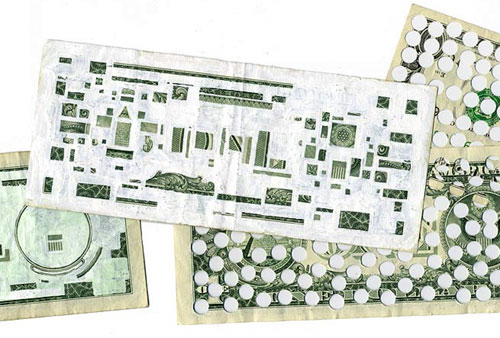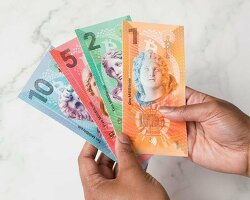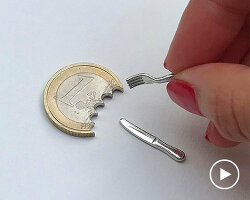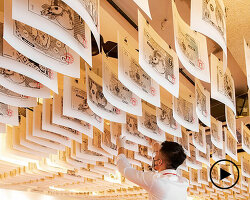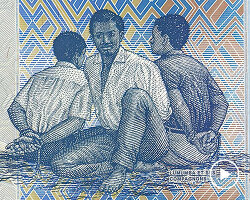‘my money, my currency’ by hanna von goeler
it is said that recession provokes artists, designers and alike to create some of their best work but for some people money is the constant source of question regardless of the economic climate.
money is many different things at the same time. it’s a work of art, a medium of exchange, a representation of value, one, which most people take for granted. everybody has their own answers when it comes to money yet we think that it is more generative and engaging to think about values and doubt. it is a balancing force.
money creates a mood of euphoria. money is one of the major constituents in determining what our lives feel like, what our typical day feels like. money also represents our society. it’s everywhere but money is just an idea – an abstract measurement.
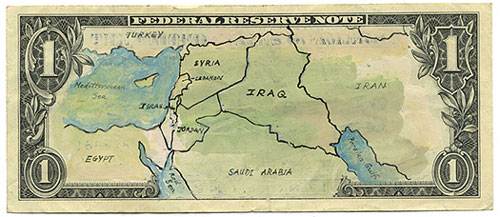 ‘my money, my currency’ by hanna von goeler
‘my money, my currency’ by hanna von goeler
this is worth…? it’s rather like the chicken / egg question, there are phrases that we appropriate, and phrases that appropriate us. money is paper, money is metal but in and of itself, it is absolutely worthless. once upon a time, money was a little bit more solid an english pound was just that, a pound of english sterling, whilst a dollar was a gold coin. but today money is virtual.
the inequities of money. money is dirty. money kills. it is usually a symbol of power or love, given or withheld.
making money. money seems to go nowhere, the objective present at money seems missing.
some artists have x-ray eyes and can see through all of that cloddish substance, which prevents us from having a clear perception of its ‘physical’ reality – free from the general claims of ‘economic idealism’. while others prefer to enhance the surface of banknotes to cast light over its affects and how it might be perceived.
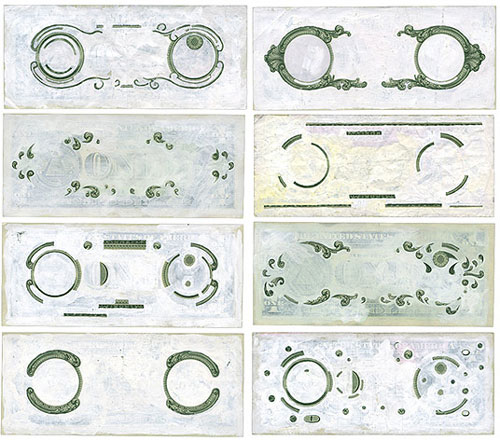 ‘my money, my currency’ by hanna von goeler
‘my money, my currency’ by hanna von goeler
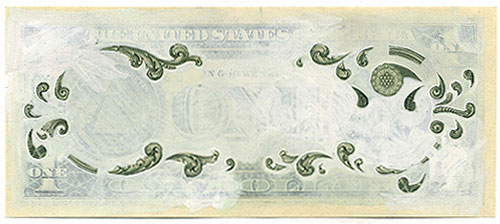 ‘my money, my currency’ by hanna von goeler
‘my money, my currency’ by hanna von goeler
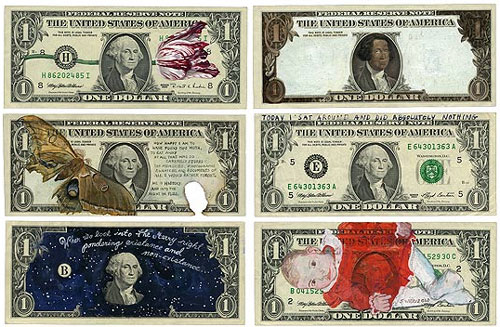 ‘my money, my currency’ by hanna von goeler
‘my money, my currency’ by hanna von goeler
‘my money, my currency’ by hanna von goeler the interstitial quality of money as it travels from person to person is the point of departure for hanna von goeler’s ‘my money, my currency’. in this this ongoing project the artist chronicles her struggle and relationship with money. exploring the ethical, political and aesthetic questions that surround notions of currency. the title of the project partially references warhol and walter benjamin with the phrase ‘my money’ but this body of work is not entirely about the reproduction of money. rather it is about the concept of currency what it is and who has it.
for the artist currency implies a general acceptance prevalence and trend. currency is about the exchange of something whether that be ideas, ethics, culture etc.
‘‘my currency is painting and drawing, my mind, ideas and spirit. money is what is there, currency is what I’ve added. drawing and painting money makes us notice its reproductive quality, as well as providing a textured way of various roles the object plays.’
‘painting on money also gives me some sense of power to determine – rather than be controlled by money’s function within society. this relates to the concept of agency; it explores the extent of to which we have the power to define rather than be defined by the currencies in our culture.’ HVG
to date von goeler has created more than five hundred one dollar artworks.
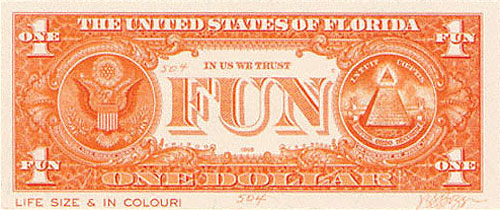 mad art by j.s.g. boggs
mad art by j.s.g. boggs
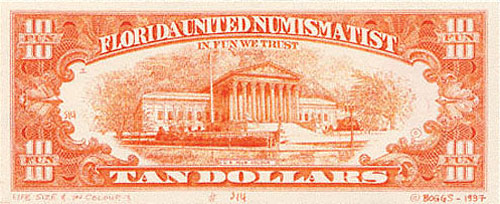 mad art by j.s.g. boggs
mad art by j.s.g. boggs
mad art by j.s.g. boggs the american artist j.s.g. boggs refuses to sell his art, instead he buys things with it. since 1984 he has made ‘mad art’, which resembles currency. he doesn’t try to pass it off as actual bills, but instead tries to convince the seller of the piece’s intrinsic worth. due to the apparent similarities between official currency and bogg’s creations the american secret service often seizes his work. there have been several trials brought against him and he was repeatedly arrested for counterfeiting both in the US and abroad.
‘once I was an abstract painter, and I wanted to paint something real, so I started painting numbers. then I realized that numbers are not real they are total abstractions. money is also an abstraction; the transaction makes it real. for example using a boggs bill to buy a hamburger and receive in change, in other words what do you think it’s worth? and then the discussion ensues.’
‘my money looks completely different to ‘real’ money it is printed on one side and not on two. some are orange, some are red, some are green and some are yellow. they have my thumbprint on the back, they have my name on them – its unmistakably my work. no one would ever say that it was printed by the government or whoever, it’s a work of art about money’ j.s.g. boggs
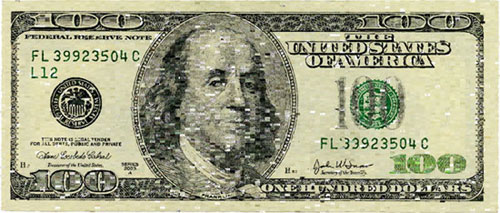 ‘ten thousand cents’ digital artwork by takashi kawashima and aaron koblin
‘ten thousand cents’ digital artwork by takashi kawashima and aaron koblin
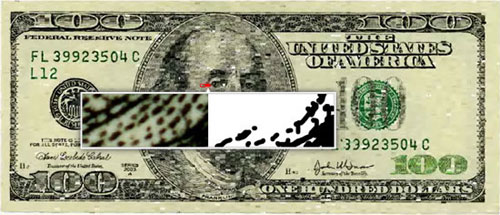 detail of the ‘ten thousand cents’ digital artwork
detail of the ‘ten thousand cents’ digital artwork
ten thousand cents digital artwork by takashi kawashima and aaron koblin ‘ten thousand cents’ is a digital artwork that creates a representation of a 0 USD bill. the people behind the project, takashi kawashima and his partner aaron koblin, divided a 0 USD bank note into 10,000 sections. next they recruited participants using amazon’s ‘mechanical turk’, to reproduce one of the sections each, using a custom drawing tool, each participant was paid 1 cent. after five months of waiting, kawashima and koblin received all their digital reproductions.
the finished work is presented as a video piece with all 10,000 parts being drawn simultaneously. the project explores the circumstances we live in, a new and uncharted combination of digital labor markets, ‘crowdsourcing,’ ‘virtual economies,’ and digital reproduction. http://www.tenthousandcents.com
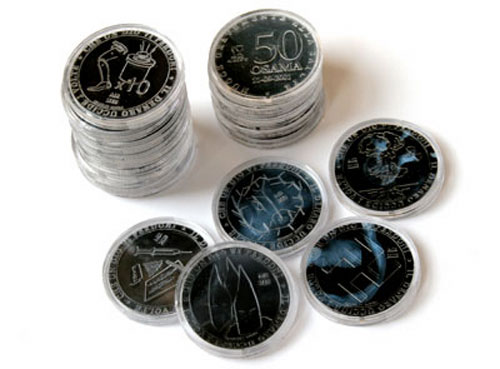 ‘transparent/ x-ray coins’ by an unknown artist
‘transparent/ x-ray coins’ by an unknown artist
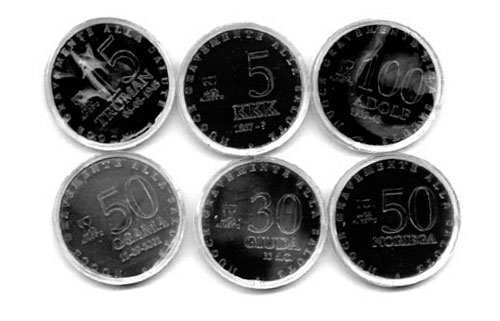 ‘transparent/ x-ray coins’ by an unknown artist
‘transparent/ x-ray coins’ by an unknown artist
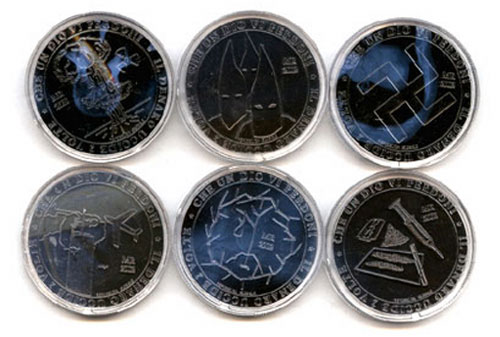 ‘transparent/ x-ray coins’ by an unknown artist
‘transparent/ x-ray coins’ by an unknown artist
transparent/ x-ray coins by an unknown artist each coin is made from clear plastic which seals an x-ray inside. the pieces feature the figure-heads and tyrants behind human atrocities, ‘evil’ organizations and world changing events in history: hitler, stalin, osama bin laden, judas, noreaga and ‘god’ are included.
the value of the coins is relative to the cost each person had on human life and the suffering they caused. for example hitler’s is valued at 100 with noreaga and bin laden worth 50, the klu klux klan is worth 5 and the lowest denomination 1 is god. the text reads: ‘money seriously damages your health’.
the other side of the coin shows a graphic representation of the persons legacy- for example bin laden’s coin depicts the twin towers with noreagas’ showing narcotics and firearms. along with this the text reads: ‘let a god forgive them’ and ‘money kills twice’.
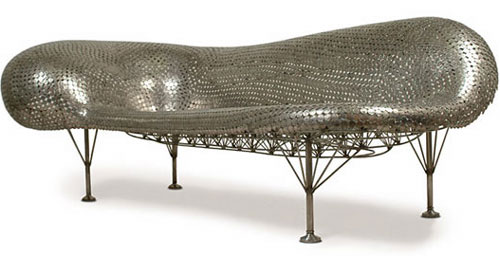 money furniture by johnny swing
money furniture by johnny swing
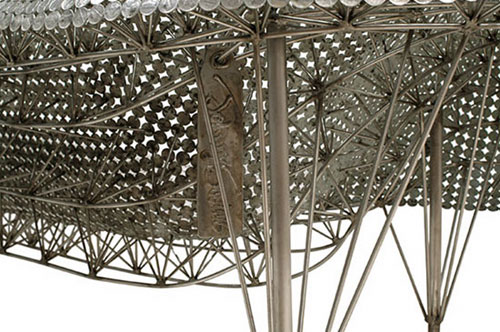 money furniture by johnny swing
money furniture by johnny swing
money furniture by johnny swing vermont based designer johnny swing’s nickel couch’ uses 7,000 nickels welded together with 35,000 welds. the couch is supported with a metal rod base that is extremely re-enforced. other pieces in the coin series include an easy chair, side chair and a bowl. swing also creates other pieces of furniture and sculptural works. read more
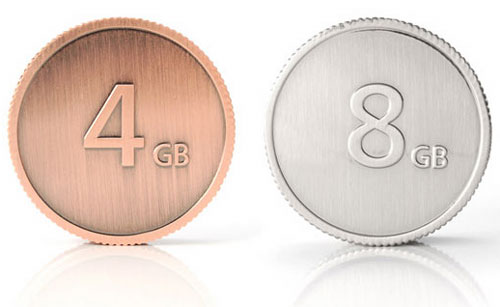 ‘currenkey’ usb flash drive by 5.5 designers for lacie.
‘currenkey’ usb flash drive by 5.5 designers for lacie.
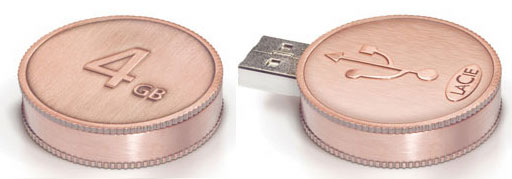 ‘currenkey’ usb flash drive by 5.5 designers for lacie.
‘currenkey’ usb flash drive by 5.5 designers for lacie.
‘currenkey’ usb flash drive by 5.5 designers for lacie ‘currenkey’ is a usb flash drive in the shape of a coin. indicated on the coin’s face is the drive’s storage capacity. the bronze edition offering 4GB of memory and the silver having a capacity of 8GB. ‘currenkey’ is meant to be a reflection on the value which we grant our data and the price we pay in order to store it safely in the IT capital. read more
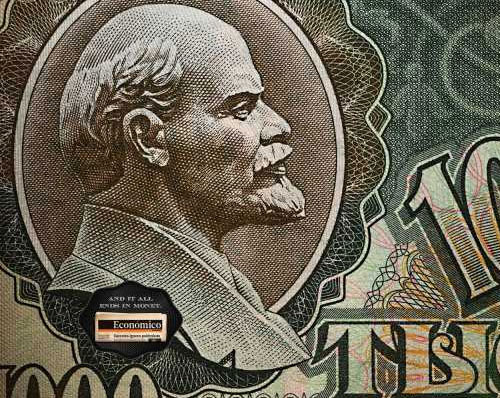 advertising campaign fischer portugal, lisbon for ‘económico’ business newspaper the tiny slogan read’s ‘and it all ends in money’.
advertising campaign fischer portugal, lisbon for ‘económico’ business newspaper the tiny slogan read’s ‘and it all ends in money’.
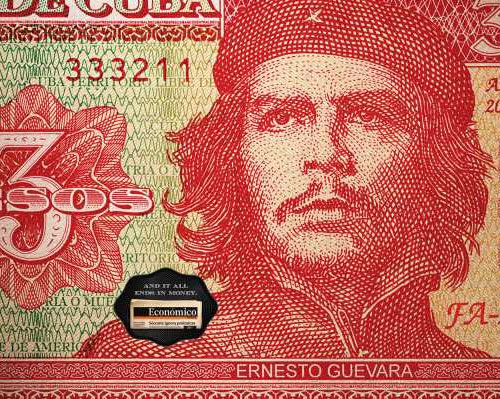
there are close to 200 countries in the world and almost as many recognized currencies in use. each one of these currencies is highly symbolic, tells stories and is a graphical representation for entire countries and regions of the world. as such its design is of great importance. in this article we look at how money developed, how it is made today and some of the design considerations.
 a collection of coins and banknotes from all over the world (photo via flickr)
a collection of coins and banknotes from all over the world (photo via flickr)
history the sumerians and the babylonians were among the first to develop the practice of trading currency, however bartering valuable goods in exchange for others has existed even longer. the earliest example of goods trading dates back over 100,000 years in swaziland, where red ochre was exchanged. other currency stand-ins included barley, precious metals like gold and silver as well as foods and spirits.
 100 florin from aruba issued in 2003 (via banknoteworld)
100 florin from aruba issued in 2003 (via banknoteworld)
 the various coinage of the kurdish dinar, krudistan (via world coin gallery)
the various coinage of the kurdish dinar, krudistan (via world coin gallery)
coinage because bartering wasn’t standardized, it was quite complicated. standardized coinage soon took over allowing people to exchange goods for money instead of other goods. gold and silver blocks were among the first units of coinage. coinage was later reduced in size, more closely resembling what we know as coins today. the touchstone was a key driver of this new coin economy, as it allowed users to determine the value of the coins by rubbing them on the stone. these primitive coins were made from metals and were crafted with designs to represent their origin. their value was in direct proportion to their weight. by pre-weighing coins and having them minted by governments, touchstones became unnecessary and users relied on the graphic design to calculate value.
 500 ngultrum from bhutan issued in 2006 (via banknoteworld)
500 ngultrum from bhutan issued in 2006 (via banknoteworld)
paper money paper money followed a similar trajectory as coinage. warehouses storing goods for people issued receipts signifying the rights to the stored goods. people would trade these receipts, transferring the goods through the form of paper. this system slowly evolved and transformed into representative currency. the term representative currency is used to describe this type of money because paper money didn’t have intrinsic value like precious coins, thus paper money only represented value but didn’t hold it. this represented a major psychological shift in the use of money. despite not having intrinsic value, paper money was backed up with valuable goods like gold.
 the various coinage of the japanese yen, japan (via world coin gallery)
the various coinage of the japanese yen, japan (via world coin gallery)
 1 real from brazil issued in 2003 (via banknoteworld)
1 real from brazil issued in 2003 (via banknoteworld)
banknotes to today while the first examples of representational money were from warehouses, goldsmiths and banks also developed similar systems that lead to the development of banknotes. this form of money was issued by banks and could be converted into an equal value of gold or silver. however this form of currency relied on the banks themselves. this system had some faults and thus slowly evolved into fiat money, which is issued by governments and isn’t backed up by anything. this is the system currently used by all of the major currencies in the world today.
 the various coinage of the egyptian pound, egypt (via world coin gallery)
the various coinage of the egyptian pound, egypt (via world coin gallery)
 the various coinage of the hong kong dollar (via world coin gallery)
the various coinage of the hong kong dollar (via world coin gallery)
currency design throughout its many evolutions, money has been designed using the latest technologies, whether they be metal forming techniques for coins or printing methods for paper banknotes. designers and artists have played a key role in giving form to currency since its inception. currency design is a small industry and most practitioners are either graphic designers or highly specialized craftspeople who are well trained in the process of making money.
 1,000 francs from the central african republic issued in 1990 (via banknoteworld)
1,000 francs from the central african republic issued in 1990 (via banknoteworld)
manufacturing paper banknotes and metal coins have very different manufacturing processes that are both highly intricate and become more advanced with every issue. banknotes are primarily printed on special paper commonly made with cotton fibres using a process known as intaglio. this printing process was originally developed in the 15th century and is used on most currencies in the world. to print a banknote using intaglio, the reverse image is incised onto a metal plate, which is usually made of zinc or copper. ink is applied to the plate and then the excess is wiped off leaving ink in the negative form. the paper is laid on top and compressed against the plate. the ink from the negative space has been transferred to the paper and the resulting image reveals the positive. this process is then repeated if there are more than a single colour involved.
while intaglio is the most common currency printing process, new polymer based banknotes have begun to gain traction in some countries, allowing a variety of other printing alternatives. polymer banknotes are more durable than their paper counterparts and can be printed using intaglio, offset printing, silkscreening or letterpress. as of 2008, only six countries have switched their currency to all polymer banknotes while a number of others are testing the new material.
coins on the other hand are made from a variety of metals and alloys with the most common being zinc, copper and nickel. these metals are rolled out and turned into large metal sheets that are then pressed to remove the blank coins. these blank coins are softened by annealing them in a furnace and then cleaned. once clean, the coins are put through the edge-rolling process that applies the pattern on the edge of the coin. once rolled, the coins move onto the coinage presses that emboss the front and back designs into the coins using incised plates similar to those used to print banknotes.
 commemorative five euro coin for dutch architecture by stani michiels (via infoaesthetics)
commemorative five euro coin for dutch architecture by stani michiels (via infoaesthetics)
form money has come in many shapes and sizes over its long history, however almost all contemporary currency uses a similar format and overall design. the size of most banknotes and coins are very similar. banknotes are primarily printed in a landscape format on both sides using a single colour or a combination of a few. they are mostly made with a 2:1 ratio of length to height and measure on average 15cm long. each bill is printed with is country of origin, value and date of issue. depending on the design and country, the bill may also show other information. they are commonly issued in a number of higher value denominations, which are differentiated by colour, shape and pattern or design. banknotes also feature a number of security features like hologram stickers or special colour changing inks.
coinages of different currencies also share many similarities. coins are typically very small with the biggest being no more than a few centimetres in diameter. some are a single colour ,while others combine two or more pieces to create more intricate patterns and designs. coins are issued in a number of smaller denominations and are differentiated by size, shape,texture and their visual design. their embossed patterns depict images and text and in most cases can be differentiated by the visually impaired.
 500 kronur from the faeroe islands issued in 2004 (via banknoteworld)
500 kronur from the faeroe islands issued in 2004 (via banknoteworld)
 the various coinage of the malaysian ringgit, malaysia (via world coin gallery)
the various coinage of the malaysian ringgit, malaysia (via world coin gallery)
 10 bolivares from venezuela issued in 2007 (via banknoteworld)
10 bolivares from venezuela issued in 2007 (via banknoteworld)
subjects as mentioned in the form of money, most coins and banknotes features a variety of subjects in addition to the country of origin, value and date of issue. although every currency is different, there are a number of common subjects that are depicted on money. portraits of politicians, members of royalty and cultural figures are perhaps the most iconic and common subject matter depicted on money. animals, plants, buildings, landmarks and landscapes are some of the other examples. cultural scenes and themes are popular images in contemporary currency.
joining these images and objects are different designs and patterns that serve to accent the main focus and protect it from counterfeiting. these patterns are often inspired by motifs found in the currency’s culture of origin or based on historical patterns taken from calligraphy or art.
 ‘the royal shield of arms’ new UK coinage by matthew dent (more info)
‘the royal shield of arms’ new UK coinage by matthew dent (more info)
security security has always been a key part of currency and money design. with new technology and printing techniques, today’s banknotes and coins are the most sophisticated ever produced. because coins are normally used for small denominations, less priority is given to them in terms of security. banknotes, on the other hand, are carefully protected especially the most common denominations.
the paper used is one of the primary anti-counterfeiting measures. most money is printed using a heavy paper made with fibres that can be cotton, linen or specialty colour fibres. polymer bills offer a more durable solution and can be made with small transparencies that are hard to counterfeit. the printing process also adds security, for one the intaglio process is very difficult to reproduce. patterns that are difficult to reproduce are also used to add security, as are watermarks, fluorescent dyes and micro printing. the ink itself is also another area of printing security. in additional to standard inks, intaglio printing can be done using colour changing inks, magnetic inks and thermochromatic ink. holograms that are applied to bills can also help protect them and are a specialized material hard to copy. while these security features do not guarantee protection individually, combining them in intricate ways keeps counterfeiters at bay.
 25 gulden from suriname issued in 2000 (via bank-note)
25 gulden from suriname issued in 2000 (via bank-note)
 the various coinage of the danish krone, denmark (via world coin gallery)
the various coinage of the danish krone, denmark (via world coin gallery)
links
currencies of the world http://fx.sauder.ubc.ca/currency_table.html
coins of the world http://worldcoingallery.com/countries/circ_sets/index.htm
banknotes of the world http://www.banknotes.com/images.htm
strange currencies http://www.neatorama.com/strange-currencies
more money artwork http://www.pennylicious.com
MONEY (64)
PRODUCT LIBRARY
a diverse digital database that acts as a valuable guide in gaining insight and information about a product directly from the manufacturer, and serves as a rich reference point in developing a project or scheme.
